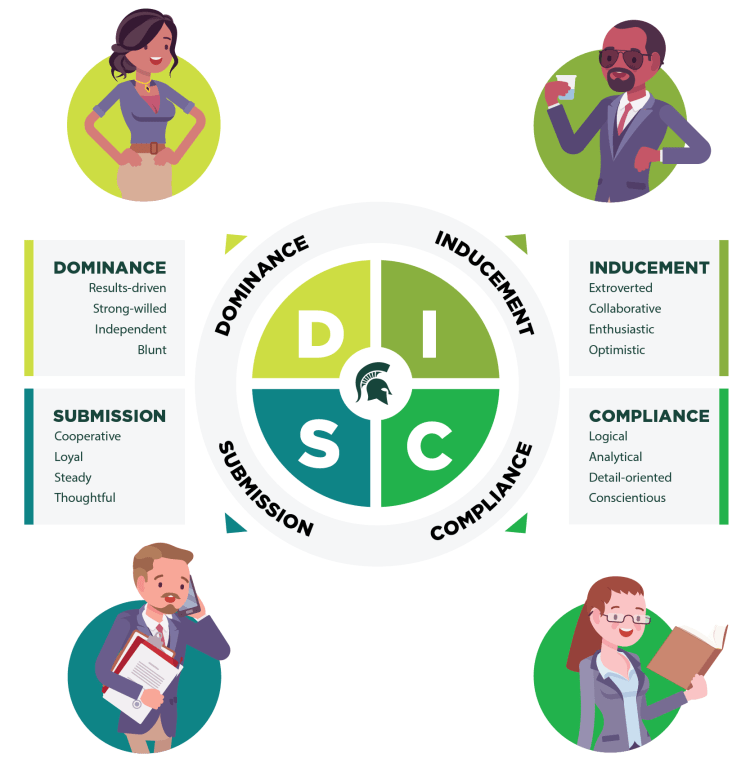Observe, Learn and Lead Your Team by Following DISC
Last Updated December 29, 2022

You want to be a more effective leader, not only in managing your team but in “managing up” with your boss. So, what should you focus on first—the process by which your team completes projects, your style of leadership or the people who make up your team? You are a leader first and foremost because you have people to lead!
Understanding the strengths, weaknesses, motivators and communication approaches of everyone on your team, as well as your own, is your starting place for understanding your effectiveness as a leader and improving the cohesion and effectiveness of your team. Numerous personality inventories exist that can help you understand and hopefully improve team member and overall team effectiveness. In academic circles, perhaps the most well-known model of personality is the “Big Five” model that measures characteristics such as agreeableness, extroversion, and conscientiousness. In business circles, other models have been well received, such as the D-I-S-C model.
What is DISC?
The DISC theory was first put forward by psychologist William Moulton Marston in his book, Emotions of Normal People. In looking to understand how normal human emotions lead to behavioral differences, Marston’s research and behavioral analysis led him to theorize that all human expression of emotions could be categorized into four behavioral types: Dominance (D), Inducement (I), Submission (S) and Compliance (C).
In Emotions of Normal People, Marston argued that these behavioral types come from people’s perception of their environment (favorable or unfavorable), their sense of self within the environment (having control or lacking control) and their interaction with others within that environment.
Using Marston’s theory, industrial psychologists and research firms developed a series of personality assessments and behavior tests to determine everything from the behavioral demands of specific positions and what personality types are best suited for the job, to testing the behavioral aptitude of candidates before they are even hired, to determining which employees may be “manager material.”
DISC-overing Your Team’s Strengths and Weaknesses
To best implement, the principles of DISC as a leader, take it out of the test mindset and how it’s used to pass, fail, or categorize people. Instead, look at the four behavioral types as pieces that complete the full picture of your team. How you’re able to relate to, communicate with and ultimately put these diverging personalities together can bolster your team’s effectiveness and your organization’s success.

Dominance
These team members are results-driven, and the faster they can produce them, the happier they are. D’s are typically the first to jump into action to solve a problem and love the challenge of doing so. They can be forceful in getting the job done because going for the “win” is what drives them. They can be competitive, overconfident, determined and strong-willed with an independent mindset—all of which can come across as haughty, impatient and not being a team player.
Dominant and direct, if you find yourself leading (or trying to lead) D style individuals, be equally direct in your communications and emphasize the desired results over the problem. If you’re a D personality yourself, keep in mind that your team may appreciate a less blunt and more supportive leadership approach and desire more detailed information before running headlong into a project.
Inducement
This was Marston’s original “I”, but many DISC assessment models may use “Influence” or “Inspiring.” The I style can be just as extroverted and action-driven as the D’s, but their approach is generally more collaborative, enthusiastic and optimistic. They want to influence others to reach a group consensus, as building relationships is important to them.
The I style can be the talkers on the team, so keep that in mind when communicating with them. Keep it positive, relatable and allow I’s to ask questions and be heard. If you’re an I style leader, your priority of building team consensus through influence, inspiration and positive enthusiasm can be effective but make sure you have a clear focus and that you’re direct with facts and desired outcomes. Otherwise, your C’s (more on them in a minute) may thirst for more information and the D’s may be hard to “influence.”
Submission
Also “Steadiness” or “Supportive,” your S team members bring a spirit of easy-going cooperation, loyalty, and collaboration, but desire it in a stable environment. They don’t always deal well with change or multitasking. Instead, their work is thoughtful, calm and thorough. In leading S style personalities, express a personal interest in them and politely state clear expectations.
As you’ve probably gathered, a combination of D and S individuals can be a flashpoint on a team, with fast-acting D individuals losing patience with and possibly running roughshod over S team members, who in turn may see the D’s as aggressive bullies. If you have more of an S personality, remember that your approach may not always be valued by your own directors, especially if your boss is a D who wants immediate results. You may need to intentionally “manage up” to promote your recommendations (and yourself!) and to clarify ambiguous expectations. While your consistent S-style leadership may foster a sense of team cooperation and appreciation, the D’s and even some of the enthusiastic I’s on your team may push for more decisive action.
Compliance
Also “Conscientiousness” or “Cautious,” your C team members are detail-oriented experts. They approach any task grounded in logic and reasoning and expect to have all the facts and information before they get started. Once they dive in, it’s easy for them to get lost in the work as they value accuracy, competency and the quality of their work above everything. While that quality control can produce flawless results, their propensity for overanalyzing and isolating themselves can sometimes stagnate the results.
To lead C individuals, you have to know your details because that is what they want. They may see any “rah-rah” or “touchy-feely” communications as patronizing or as an impediment to their process. If you have C style in your leadership, letting go of projects may be hard for you, but you need to delegate tasks to your team, especially to D’s who are looking for an opportunity to perform. While being informative and detail-oriented with a “just the facts” approach may seem precise and efficient, it can come across as impersonal, especially to I’s and S’s who may desire a more relational or emotionally expressive approach.
Bring Your Team Together
Using the DISC theory or other personality theories such as the Big Five can help you understand the behaviors and personality types on your team. However, personality “types” do not represent hard and fast divisions. You may have recognized several of the styles in one individual on your team and even within yourself. Avoid the temptation to pigeonhole team members (or yourself) into one type. Also, be careful not to determine one behavioral type as a strength and another as a weakness, especially when it comes to the qualities of leadership. It is all a matter of fit.
Returning to the DISC model for example, while it could be said that the “Dominance” of D’s makes them “natural born leaders” and the “Submission” and “Steadiness” of the “Supportive” S types makes them more likely to be the followers of these dominant leaders, many in the field of leadership and management are reevaluating how they assess and define leadership qualities, putting a greater emphasis on emotional intelligence than emotional charisma.
Jennifer Wolf, a program manager for Lowe’s Companies, Inc. and a graduate of Michigan State University’s Master of Science in Management, Strategy and Leadership program, uses DISC to better communicate and interact with her teams, peers and leaders. It has also taught her about her own behaviors and leadership style.
“It has changed how my employees respond to my leadership and have created more dedicated employees,” Wolf says. “People are fluid and learning how to interact with them is important. Understanding that there are various ways this can be done is a good tool to have.”

